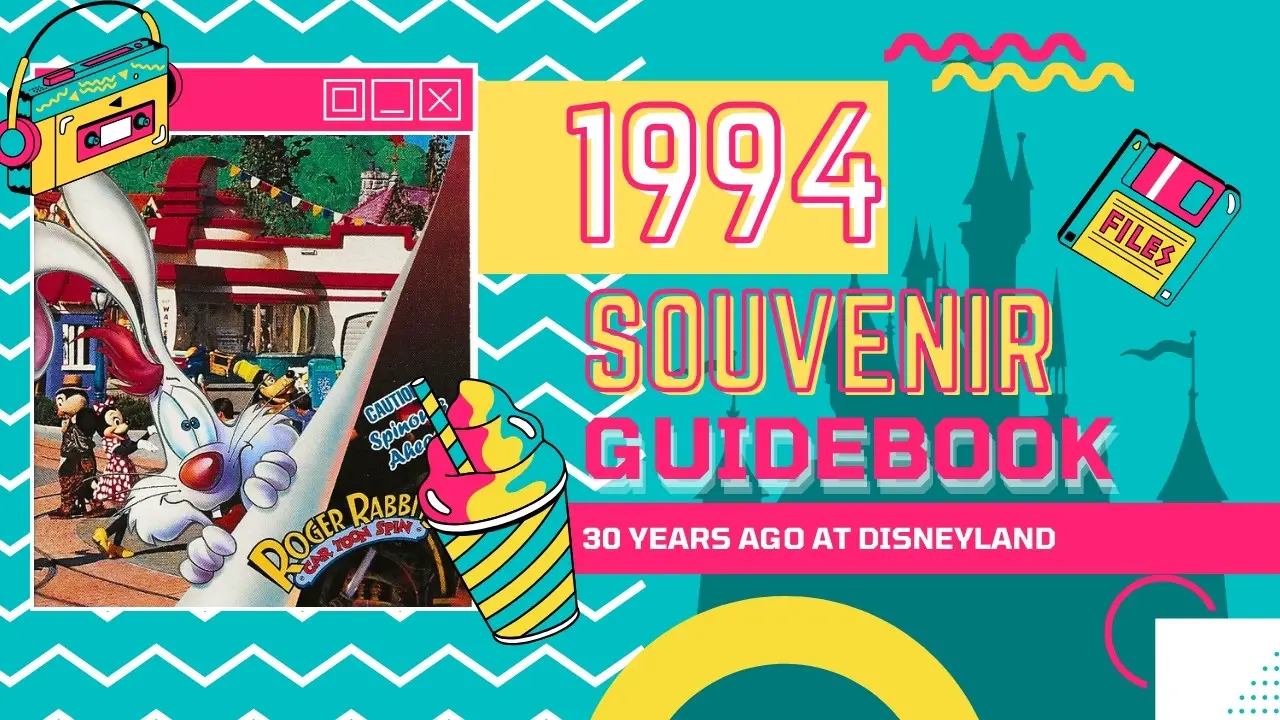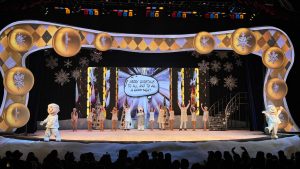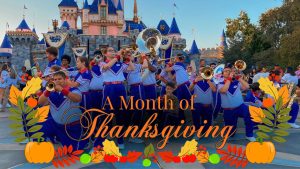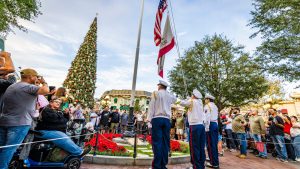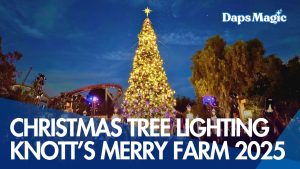
In 1994, Disneyland was still handing out, free of charge, a guidebook that was essentially a thirty six page full color booklet. This continued a trend that had begun at the start of the decade; the only change was a barely discernible increase in the number of pages.
It is true that today’s “Guidemap” is not nearly as large. The single foldout that is still distributed, free of charge, consists of six pages joined end to end, double sided. It has no sponsors (the guidebooks of the 1990s were compliments of Kodak and American Express). But consider this: two of Disneyland’s major contemporaries, Knott’s Berry Farm and Universal Studios, no longer offer any paper collateral of any kind on a daily basis. Everything there is entirely app based (something which Disney offers as well).

But none of this, of course, was even a gleam on the horizon as guests eagerly opened up their official 1994 Disneyland Guidebook. The front illustration depicted the ubiquitous Roger Rabbit “peeling back” the cover to reveal the latest attraction, Roger Rabbit’s Car Toon Spin (covered here in this year’s January column). Naturally, the inside front cover offered a vivid description of Disney’s “newest spinsation” and yet another illustration of Roger. Also of note was an honest-to-goodness Table of Contents. That’s right, this guidebook was just that weighty.
I will not cover every page of this particular edition, but I will be sure to cover each of Disneyland’s eight “lands,” as well as a couple of other features.

One of these features was Disneyland’s “Healthy Foods” guide. In the past, guests had been content with the basics, presented along with some slightly more “adventurous” meals offered in New Orleans Square and the Tahitian Terrace, which was, in 1994, Aladdin’s Oasis (but not for long!). By the 90s, however, Disneyland wanted guests to be assured that there were healthy alternatives, including absolutely fresh fruits and vegetables, nonfat frozen yogurt, and even an avocado and alfalfa sprout sandwich, which had to be specially requested at the Carnation Ice Cream Parlor and Restaurant. It should be noted that one of Michael Eisner’s personal contributions, the ground turkey burger, was no longer on the menu.
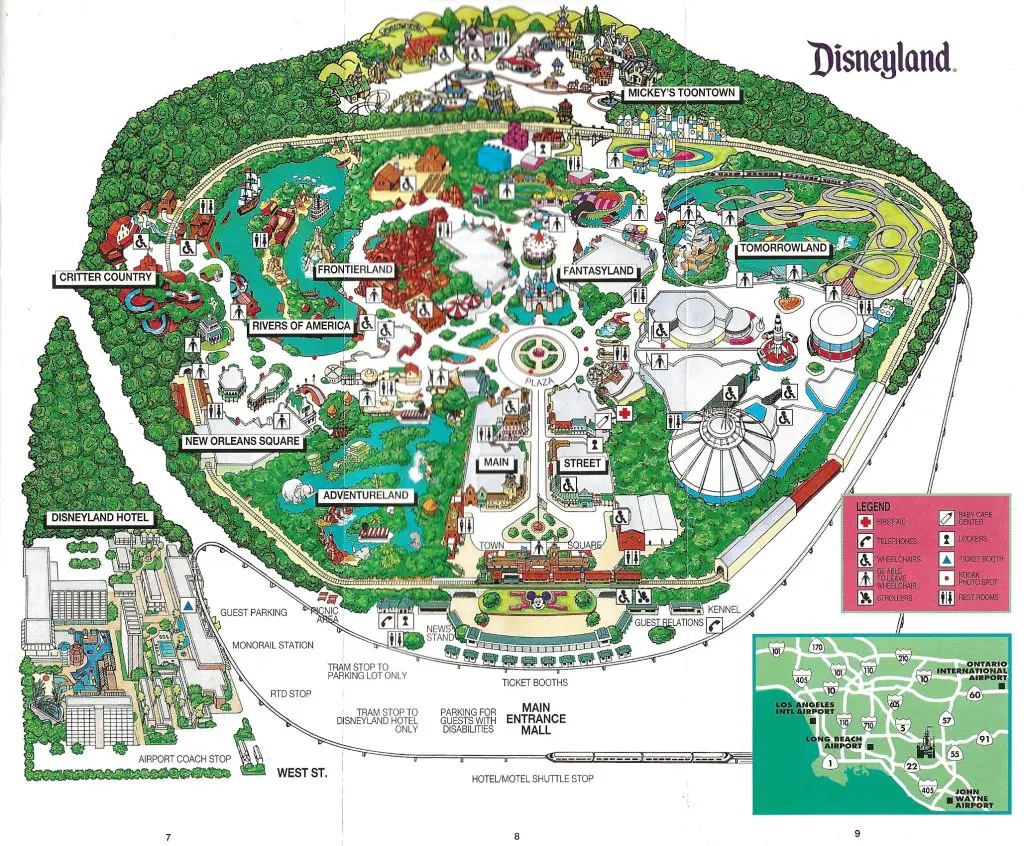
But enough of healthy eating, let us dive into the real “meat” of the Disneyland Guidebook, the park itself, and its many attractions, shops, and (yes) dining locations. Pages seven through nine consisted of a fold out map of the entire park, along with the Disneyland Hotel (now owned by Disney) and a helpful Southern California freeway map. That new “bump” across the top of the map no longer seemed quite so unusual, as Toontown was now just as much a part of Disneyland as Critter Country.

We begin our tour on Main Street USA. Interestingly, this is the only land in the 1994 guidebook to include a category for Information and Services. Those are the locations marked with the green diamonds, and include such stalwarts as City Hall (number 4), First Aid (number 7), Lost Children (also number 7), and the Bank of Main Street (2).
Red diamonds denote Attractions. Surprisingly, Main Street has a respectably high count in this category, with a total of eight. The Disneyland Railroad (14) and all of those Main Street vehicles (10-13) make up the bulk of the list. And there is also the attraction that holds the record for the longest official name in the history of Disney theme parks: The Walt Disney Story, featuring Great Moments with Mr. Lincoln (15).
Blue diamonds are for shops. Main Street, of course, contained more shops than any other designated land. In 1994 there were 23 separate shops on Main Street, ranging from the full service Emporium (21) to the tiny Silhouette Studio (38).
Finally, there are the yellow diamonds, for Restaurants and Refreshments. Because Main Street claimed both the Plaza Pavilion (44) and the Plaza Inn (45), as well as the Carnation Plaza Gardens (47) opposite the Plaza Inn, there were nine dining locations officially located on Main Street. One “lost” location is the Main Street Cone Shop (48), located at the end of East Center Street. You can still find this location, just to the left of the entrance to the lockers, and will note that there are ice cream cones etched into the glass service window. (But there are no ice cream cones.)
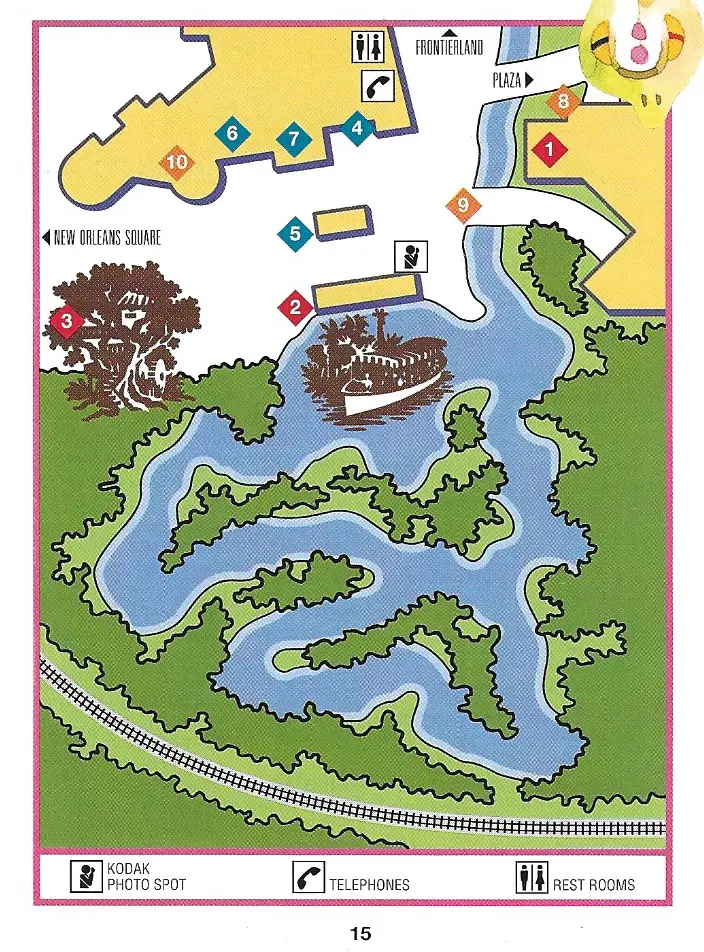
After the riches of Main Street, Adventureland’s offerings are startlingly modest. Here guests would find just three Attractions: The Enchanted Tiki Room (1), Jungle Cruise (2), and Swiss Family Treehouse (3). (The Robinsons had not yet vacated in favor of Tarzan.) There were three shops in a single large facility on the north side of the street: the Adventureland Bazaar (4), Tropical Imports (5), and Safari Outpost (6). A fourth, South Sea Traders (7), was little more than a kiosk.
In keeping with the trilogy theme, Adventureland had but three dining locations: the Tiki Juice Bar (8), Aladdin’s Oasis (9), and Bengal Barbecue (10). The Oasis and the Barbecue were both still new in 1994. Given any odds, I would have said that Aladdin’s Oasis would be the one to stand the test of time. And I would lose. Bengal Barbecue has maintained a steady and loyal fan base for over thirty years; the Oasis would be shuttered within a year and only recently would the forlorn location finally be reimagined as the Tropical Hideaway.

New Orleans Square is, of course, a different story. Granted, in 1994 it boasted of just four Attractions. But two of these, Pirates of the Caribbean (1) and the Haunted Mansion (2) topped every list of must-see experiences. Rounding out that list was the Disneyland Railroad (4), and, curiously enough, The Disney Gallery (3). Sited above the entrance to the Pirates of the Caribbean, the Gallery had the unusual distinction of being considered both an attraction and a shop.
Speaking of shops, New Orleans Square offered eleven shopping experiences, surpassed only by Main Street, and equalled only by Fantasyland. But neither could match the sheer quality of merchandise in the New Orleans Square of 1994. There was custom-blended perfume at Mlle. Antoinette’s Parfumerie(10), custom-made hats and handbags at Marche aux Fleures, Sacs et Mode (11), specialty Mardi Gras merchandise at Mascarade D’Arlequine (13), as well as hand painted parasols (15) and hand painted portraits (14). Finally, holding pride of place in 1994 was the much admired and much lamented One of a Kind Shop (6), still offering choice antiques, curios and what-have-yous for the discriminating collector.
New Orleans is famed for its fine dining; Disneyland’s New Orleans Square is, as well. The signature experience is the Blue Bayou (18), with table service in an atmospheric setting overlooking the boat launch for the Pirates of the Caribbean. Six other dining options were offered, ranging from the French Market(19) to the La Petite Patisserie (22).
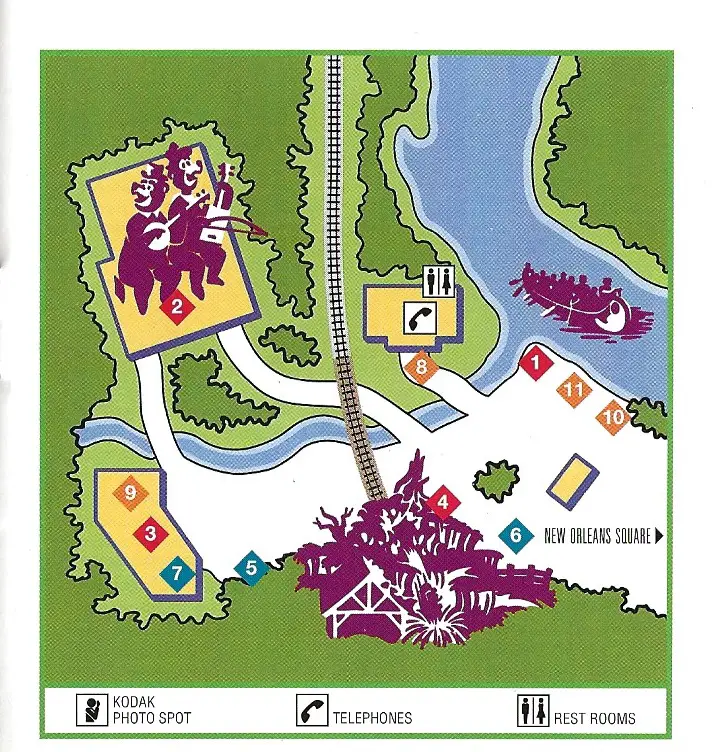
In 1994, Critter Country had but four Attractions, and one of those, Teddi Barra’s Swingin’ Arcade (3) was a bit of a stretch. But two signature attractions, the Country Bear Playhouse (2) and Splash Mountain (4) more than made up for it. Rounding out the attraction list was the venerable Davy Crockett’s Explorer Canoes (1), which had the unusual distinction of having appeared in three lands without ever moving (Frontierland, Bear Country, and Critter Country). When the area is renamed Bayou Country later this year, that count will go up to four.
Critter Country’s three shops were an oddly disparate group. The Crocodile Mercantile (7) offered handcrafted items, clothing, and official Splash Mountain Souvenirs. The Professor Barnaby Owl Photographic Art Studio (5) was simply a location to purchase your Splash Mountain photo. Then there was the Briar Patch (6), a new theming for the original Indian Trading Post, offering Winnie the Pooh merchandise.
For dining, Critter Country basically begins and ends with the Hungry Bear Restaurant (8). But there is also Brer Bar (formerly the Mile Long Bar) (9), a fruit cart (11) and, for some reason, the Harbor Galley (10), which seems to have been exiled from New Orleans Square.

By page 21 in the 1994 guide book, we are getting back to the “core” lands of Disneyland, so to speak. Frontierland features a respectable nine attractions, including no less than three ways to circumnavigate the Rivers of America: Mark Twain Riverboat (4), Sailing Ship Columbia (5), or Mike Fink Keel Boats (8). For the “wildest ride in the wilderness,” guests could choose Big Thunder Mountain Railroad (3). And in case you were wondering, (2) is the Big Thunder Ranch, which at this time still included the petting barnyard.
Shops in Frontierland were pretty basic in 1994. Davy Crockett’s Pioneer Mercantile (11) included three other shops: Bonanza Outfitters (14), Frontierland Hats (12), and a Candy Shop (13) that seems to have been not-quite-erased from the map. Across the street stood Westward Ho Trading Company (10).
Even thirty years later, Frontierland has a couple of the more popular Restaurant & Refreshment locations. Casa Mexicana (15) may have been replaced by Rancho del Zocalo, but the Golden Horseshoe (16) is still serving up meals and drinks (just without the “rip snortin’” shows). A couple of options that are long gone are the Big Thunder Barbecue (19) and Tom Sawyer Island Canteen (21)

When it comes to Attraction count, no land could (or can) touch Fantasyland. In 1994 there were no less than fifteen attractions identified. Only two, the Skyway (5) and Videopolis (7) are no longer with us. All the rest are still going strong, although Snow White’s Scary Adventure (1) has been made a little less scary in recent years.
The Shops list for 1994 yielded up eleven locations, ranging in age from the Tinker Bell Toy Shoppe (18) to Small World Gifts (22). A notable location was the Kodak Camera Kiosk (21), occupying the last remaining “central” ticket booth in Disneyland, in a relocated position.
Pinocchio’s Village Haus restaurant (27) was, and is, the sole “sit down” dining location in Fantasyland (today it is the Red Rose Tavern). The trendy Yumz snack bar (28) is still with us (as the Troubadour Tavern), but the whimsical Ice Cream Train (29) is no more.
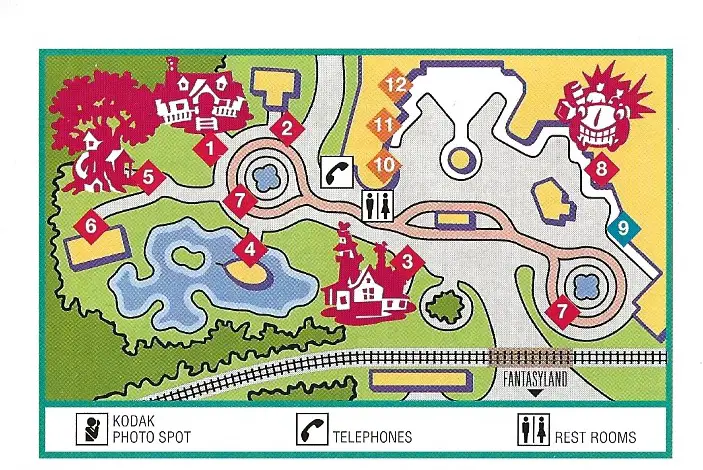
It makes sense that Disneyland’s newest land in 1994, Mickey’s Toontown, would have the lowest count for Attractions, Shops, and Restaurants & Refreshments. That first category count was eight, but only because every residence around Neighborhood Lane (that’s a real thing; look it up) was considered a separate attraction. For Shops, there was just one, although it was identified as both the Gag Factory and the Five and Dime (9). (It just depended on which door you used.) Oddly, in this map it was misplaced to the wrong side of the newly opened Roger Rabbit’s Car Toon Spin (8).
Toontown’s “restaurant row” boasted only three eateries: Daisy’s Diner (10), Pluto’s Dog House (11) and Clarabelle’s Frozen Yogurt (12). There’s your healthy eating!

Our guide book tour of the Happiest Place on Earth winds up with Tomorrowland. No less than twelve Attractions are listed, some of which are still with us. Thirty years ago you would have found Space Mountain (4), the Submarine Voyage (9) and Star Tours (12) in the same places they are found today. This is not the case, however, for the PeopleMover (3), Skyway (6), or Circle Vision (11).
Tomorrowland’s Shops and Restaurants & Refreshments were limited to three each. The Star Trader (13) and Hatmosphere (14) can still be found in the same locations. The Premiere Shop (15), offering Mighty Ducks souvenirs and other licensed sports apparel is not to be found. You will also find the Tomorrowland Terrace (16) serving lunch and dinner, but not the Lunching Pad (17) or Space Place (18).

I thought it was worth sharing the full two-page spread for the Disneyland Hotel. Disney was aggressively positioning the hotel as an integral part of the Disneyland experience. At this time, the “Disneyland Resort” was still seven years away. So the Hotel was a part of the park guide book, complete with a list of “Attractions” that included remote control miniature tugboats (5), boot scooting and cowboy karaoke at the Neon Cactus (6) and… Koi Fish (8).
Shopping and dining were definitely in the hotel wheelhouse. The Shops count was woefully off (a loss to those of us in the future when trying to figure out just how many shops there were in Monorail Plaza and the Plaza Building), but an even dozen Restaurants & Refreshment locations is right.

Following a few more pages of ads (Disney’s The Fox and the Hound, now available on home video!), Disneyland Trivia (Including this startling item: “Walt’s father, Elais (sic) Disney, participated as a building contractor on the construction of the Mark Twain steamboat in Frontierland.” Startling, because Elias Disney passed away in 1941.), and Kodak camera tips, came the inevitable back cover, and full page ad for (what else?) Kodak film. Why trust your memories to anything less?

